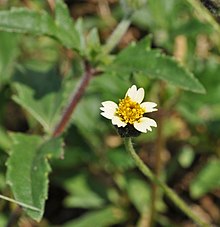Tridax procumbens
| Tridax procumbens | |
|---|---|
 |
|
| Scientific classification | |
| Kingdom: | Plantae |
| (unranked): | Angiosperms |
| (unranked): | Eudicots |
| (unranked): | Asterids |
| Order: | Asterales |
| Family: | Asteraceae |
| Tribe: | Heliantheae |
| Genus: | Tridax |
| Species: | T. procumbens |
| Binomial name | |
|
Tridax procumbens L. |
|
Tridax procumbens, commonly known as coatbuttons or tridax daisy, is a species of flowering plant in the daisy family. It is best known as a widespread weed and pest plant. It is native to the tropical Americas, but it has been introduced to tropical, subtropical, and mild temperate regions worldwide. It is listed as a noxious weed in the United States and has pest status in nine states.
Its common names include coatbuttons and tridax daisy in English, jayanthi in Kannada, cadillo chisaca in Spanish, herbe caille in French, jayanti veda in Sanskrit, ghamra in Hindi, bishalya karani (ବିଶଲ୍ୟକରଣୀ) in Oriya, kambarmodi in Marathi, gayapaaku (గాయపాకు) & gaddi chemanthi (గడ్డి చామంతి) in Telugu,vettukaaya poondu or kinatruppasan (கிணற்றுப்பாசான்) in Tamil,kotobukigiku in Japanese and tīn túkkæ (ตีนตุ๊กแก; "gecko feet") in Thai.
The plant bears daisylike yellow-centered white or yellow flowers with three-toothed ray florets. The leaves are toothed and generally arrowhead-shaped. Its fruit is a hard achene covered with stiff hairs and having a feathery, plumelike white pappus at one end. Calyx is represented by scales or reduced to pappus. The plant is invasive in part because it produces so many of these achenes, up to 1500 per plant, and each achene can catch the wind in its pappus and be carried some distance. This plant can be found in fields, meadows, croplands, disturbed areas, lawns, and roadsides in areas with tropical or semi-tropical climates. It is listed in the United States as a Noxious Weed and regulated under the Federal Noxious Weed Act.
...
Wikipedia
